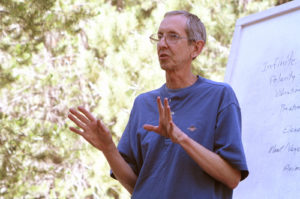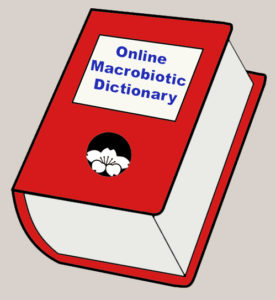
Completed Entries
A theoretical state of equal amounts of yin and yang energies. This state is not possible because nothing is ever neutral—there is always yin or yang in excess. Still, being as close to centered as possible is viewed as desirable. Adjectives often used with balance include: dynamic, delicate, healthy, good, and normal human.
“The bigger the front, the bigger the back.” This principle negates the law of the excluded middle. This law is similar to the saying that something is too good to be true and the scientific principle that every action creates an equal and opposite reaction. An example is nuclear energy—a great front in the production of energy but a great back in terms of an accident or fallout. This is the fourth of Seven Laws of the Order of the Universe.
See Logic, Aristotelian.
Consuming foods that have a near equal amount of yin qualities and yang qualities and thus have a centering effect. In the largest sense, this means a diet based on whole grains and fresh vegetables rather than meat and sugar.
Japanese roasted green tea made from twigs and leaves from the tea plant that is at least three years old before harvesting. It has a low caffeine content, about one-fifth as much as green tea. The optimum proportion of twigs to leaves is considered to be six parts twigs to four parts leaves. Tea that is 100 percent twigs is called kukicha twig beverage.
Warm bancha tea mixed with salt and used to swab the eye and as a compress in cases of mild eye pain.
See Cautionary note.
Bancha (or green) tea leaves mixed with saliva and applied to insect stings or bites.
See Cautionary note.
Hot bancha tea and salt used as a gargle for sore throats or throat swelling.
See Cautionary note.
Natural sweetener, usually made from barley extract and sprouted corn.
“A bath refers to a medium in which the body is wholly or partly immersed or with which the body is cleansed. The medium may vary from water or liquid that is mostly water to vapor, sand, or mud…The bath medium may also be used as a sponge bath.” Natural Healing from Head to Toe, 171. See also Hip bath, therapeutic.
See Cautionary note.
Arame bath: Water from boiled arame used as a full bath mainly to help increase circulation and remove excess salt. Mustard powder or salt is sometimes added to further improve circulation. Grated ginger is added to help reduce fever.
Beach sand bath: The burying of one’s body in sand to help remove toxins from the body and to strengthen the kidneys.
Cedar leaves bath: Water from boiled cedar leaves in which one immerses only the hands or feet to help reduce pain or swelling in those areas.
Chestnut leaves bath: Water from boiled chestnut leaves used as a full bath for skin disorders.
Daikon bath: Water from boiled daikon used as a full bath mainly to help increase circulation and remove excess salt. Mustard powder or salt is sometimes added to further improve circulation. Grated ginger is added to help reduce fever.
Ginger bath: Water from grated ginger used as a full ball for adults only mostly to improve circulation, remove old salts from the body, or for skin disorders.
Ginger foot bath: Water from grated ginger used as a water foot bath for blood circulation, kidney disorders, and insomnia.
Mustard powder bath: Water from boiled mustard powder used as a full bath to improve circulation.
Mustard powder foot bath: Water from boiled mustard powder used as a foot bath to improve circulation.
Peach leaves bath: Water from boiled peach leaves used as a sponge bath for dandruff, prickly heat, or ringworm on the scalp or face.
Pine needles bath: Water from boiled peach leaves used as a sponge bath for dandruff or ringworm on the scalp or face.
Rice bran bag: Rice bran in a cotton bag soaked in hot water used like a sponge bath for skin problems.
Rice bran bath: Water from boiled rice bran used as a full bath for skin problems.
Salt bancha eye bath: Water from warm bancha tea and salt used as a sponge bath for eye (or ear) problems.
Salt bancha nasal bath: Water from warm bancha tea and salt used to flush/clear the nostrils or to stop nosebleeds.
Salt bath: Salt water used at any comfortable temperature as a full bath to improve the kidneys, relieve pain, correct mineral imbalances, and other conditions.
Saltwater bath: Cooled salt water used specifically for burns.
Water foot bath: Hot water to cover the feet used for blood circulation, kidney disorders, and insomnia.
The burying of one’s body in sand to help remove toxins from the body and to strengthen the kidneys.
See Cautionary note.
Transparent noodles made from bean, potato, or other starch. Harusame is the Japanese name; saifun is Chinese.
Sauce made by roasting flour in oil and adding liquid. Common in French cooking.
The leaves of the beefsteak plant (perilla frutescens var. crispa), a popular Japanese herb that is purple-red in color. The leaves are used in making of umeboshi plums. See also Shiso.
Being open to new ideas like a small child, meaning without preconceived biases. This term comes from the Zen concept of “shoshin,” which is translated as beginner’s mind. Ohsawa uses the term also to mean accepting challenges gratefully.
Trust or confidence in something considered to be true without empirical evidence or rigorous proof. Ohsawa cautioned against a blind belief in medicine that heals only symptoms or a blind belief in macrobiotics. He believed that this kind of blind confidence often ends in tragedy. According to Herman Aihara, his favorite motto was “non credo,” meaning do not believe without verifying for oneself.
Excessive indulgence, usually for a short period of time, by eating extreme yin foods or drinking alcoholic beverages as a result of restricting food choices too much, trying to yangize too quickly, or using too much salt.
A theory that one element can change to another within the healthy body as long as internal heat from movement or exercise is available. “The process of transmutation goes on whenever there is life, no matter what sort of diet we follow. By understanding how it works, we can truly be the creators of ourselves and our existence.” Zen Macrobiotics, 30.
The human body contains two blood circulatory systems that are connected. Systemic circulation provides blood and thus oxygen and other vital substances to organs, tissues, and cells. Pulmonary circulation is where fresh oxygen enters the blood. Good quality blood circulation is vital to optimal health.
The macrobiotic view of blood formation is that the villi of the intestinal walls take digested foods into its structure, assimilates, and finally transforms them into the red blood cells. These red blood cells circulate throughout the body and transform themselves into body cells. Therefore, one’s condition and character depend directly on one’s food.
The pH scale measures the amount of acid and alkaline in any substance based on the activity of hydrogen in a solution. If acid predominates the pH is below 7.0 and if alkaline predominates the pH is above 7.0. The body has several buffer systems to maintain blood pH between 7.37 and 7.43 (slightly alkaline). Thus, the macrobiotic opinion is to consume food and drinks daily that are slightly alkaline forming in total and to avoid or minimize those that are strongly acid or alkaline forming and thus more challenging to balance.
.
Japanese fish usually found dried and shaved, used for soup stock or condiment.
A dried fish product made by steaming, sun-drying, smoking, and then fermenting a fish of the mackerel family.
Breastfeeding is preferred in all cases unless there is some problem preventing it. If breastfeeding is not possible, the macrobiotic view is to use kokkoh (grain milk) or another substitute other than cow’s milk.
A staple of the whole-grain macrobiotic approach. Although there are many varieties, short-grain, whole rice from which only the hull has been removed is rich in nutrients, easy to digest, and most beneficial for healing purposes. As with all whole grains, the greatest benefit is achieved by thoroughly chewing each mouthful thoroughly.
Mochi made with brown sweet rice.
The hulled and cracked seeds of the buckwheat plant, a relative of rhubarb. Botanically, buckwheat is a fruit, but it is often grouped with grains because of its looks and use in flour. It is available in both roasted and unroasted varieties.
Noodles made from buckwheat and usually some percentage of wheat, also known as soba. Better quality buckwheat noodles are darker in color; lighter ones have more wheat flour added. The best quality buckwheat noodles are made from 100 percent buckwheat, but these are harder to find.
Buckwheat flour mixed with hot water to make a paste-like consistency that is applied directly to the skin over an affected area. The main function of a buckwheat plaster is to remove excess water from the body. Buckwheat plasters also help remove toxins from the body, reduce swelling, and relieve pain.
See Cautionary note.
Buckwheat flour mixed with salt and hot water to make a paste-like consistency that is applied directly to the skin to help relieve arthritis pain.
See Cautionary note.
Partially cracked wheat, common in Middle Eastern cookery.
A long dark root vegetable. One of the most yang vegetables, it is especially good for the kidneys and sexual organs, and for purifying the blood.
See Cautionary note.
Seeds from the burdock plant that are useful for skin infections.
Seeds from the burdock plant mixed with saliva and used for skin infections such as boils.
See Cautionary note.
Projected Entries
Bacteria
Bainiku Ekison
Baking
Baking soda
Baldness
Barley
Basedow’s disease
Basic foods – see principal foods.
Basic Macrobiotic Cooking
Bean curds
Beans
Bed-wetting
Beef
Bento, or Obento
Beriberi
Beverages
Bile
Birds, wild
Bleeding
Boiled salad
Biological law
Blood cells, red
Blood pressure, high
Blood quality
Blood sugar level
Bok choy
Bone marrow
Bran
Bread
Bread, Ohsawa
Bread, whole
Breast cancer
Breathing deeply
Broil
Bronchitis, chronic
Brown rice miso
Buddism, Zen
Burns
Butter
Questions or Comments?




